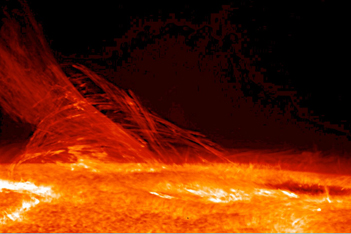Global Scans · Solar flare · Weekly Summary

A global catastrophic risk is a hypothetical future event that has the potential to damage human well-being on a global scale. Some events could cripple or destroy modern civilization. Any event that could cause human extinction is known as an existential risk.
- Scientists closely monitor solar activity to predict solar flares and mitigate their effects on Earth and in space. SciTechDaily
- A severe geomagnetic storm could cause colorful auroras over Northern California and Alabama today due to a powerful solar flare and coronal mass ejection released from the sun. CNN
- With the peak of Solar Cycle 25 expected to continue through 2025, the number of solar flares, geomagnetic storms, and auroras is likely to increase over the coming months. The Daily Galaxy - Great Discoveries Channel
- The United States on Tuesday launched a new satellite expected to significantly improve forecasts of solar flares and coronal mass ejections-huge plasma bubbles that can crash into Earth, disrupting power grids and communications. phys.org
- As the sun nears solar maximum - the peak in its 11-year cycle of activity, expected in 2024 - it becomes more active, and researchers have observed increasingly intense solar flares erupting from the fiery orb. CNN
- Certain regions of the US are more at risk from geomagnetic storms, which occur when the sun spits out solar flares and coronal mass ejections. phys.org
- Scientists are warning an increase in solar flares and coronal mass ejections from the sun have the potential to disrupt communication on Earth into the weekend. CNN
- The peak of the sun's solar cycle is forecast to occur sometime in 2024, meaning that many satellites in orbit could be disabled by the most powerful solar flares seen in decades. Forbes
- A large geomagnetic storm could interfere with radio communications on Earth from Monday, space weather forecasters have warned after spotting an outburst of plasma from a solar flare from the Sun's surface. Euronews.com
- Space weather forecasters are expecting solar flaring to reach Earth on Monday causing a geomagnetic storm and the appearance of the Northern Lights. Euronews.com
- The planet has witnessed a growing number of solar particles, CMEs, solar flares, solar storms and geomagnetic storms in the last few months, and it is expected to rise further. HT Tech
- By monitoring and classifying solar flares, scientists can better understand the Sun's behaviour and predict potential impacts on space weather, which is crucial for protecting satellites, astronauts, and technology on Earth. SciTechDaily
- The solar maximum increases the chances of space weather events impacting the Earth, but even as you move away from it as get through 2024 into 2025 and beyond, the Sun will continue to emit solar flares and geomagnetic storms. Official blog of the Met Office news team
- A significant solar flare emerged from a massive, volatile sunspot, causing disruptions in radio communication on Earth and propelling a scorching plasma stream through the sun's outer layers at a velocity of 900,000 mph. Mashable India
- The solar maximum increases the chances of space weather events impacting the Earth, but even as you move away from it through 2024 into 2025 and beyond, the Sun will continue to emit solar flares and geomagnetic storms. The Independent
- SAN FRANCISCO - Researchers will have rare opportunities over 2024 to study solar flares and coronal mass ejections, observations that could lead to improved space weather forecasts. SpaceNews
- Solar flares are powerful bursts of energy, NASA explains, and can affect radio communications, power grids, navigation signals and pose risks to spacecraft and astronauts. EL PAIS English
- Prolonged periods of high solar flare activity could have a slight warming effect on Earth's climate, while periods of low activity could have a slight cooling effect. SciTechDaily
Last updated: 31 March 2025
